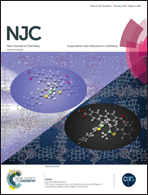Plasma polyacrylic acid and hollow TiO2 spheres modified with rhodamine B for sensitive electrochemical sensing Cu(ii)†
Abstract
We report a novel nanocomposite of hollow TiO2 microspheres and plasma polyacrylic acid (TiO2@PPAA) modified with rhodamine B (TiO2@PPAA-RhB). This nanocomposite was further used as an electrochemical sensor for the ultra-sensitive and selective detection of Cu2+ in water. A gold electrode was modified with hollow TiO2 nanospheres, followed by the closely bonded layer of PPAA via plasma polymerization. Subsequently, the carboxyl groups of TiO2@PPAA nanocomposites were activated to ester groups by N-hydroxysuccinimide/1-ethyl-3-(3-dimethylaminoprolyl) carbodiimide hydrochloride. The resultant activated ester groups reacted with the amino groups on rhodamine to form the amide groups, leading to the modification of TiO2@PPAA nanocomposites with rhodamine. Considering the synergistic effect of strong electrostatic interaction between the carboxyl groups of PPAA and Cu2+, the direct adsorption of Cu2+ on the TiO2 surface, and the coordination chemistry formed between Cu2+ and rhodamine, the developed electrochemical biosensor exhibited high sensitivity of Cu2+ detection, with a detection limit of 0.404 pM within the range of 0.001–10 nM of Cu2+. Therefore, the fabricated electrochemical sensor based on TiO2@PPAA-RhB can be obtained via plasma polymerization and represents a highly promising tool for use in environmental monitoring.


 Please wait while we load your content...
Please wait while we load your content...